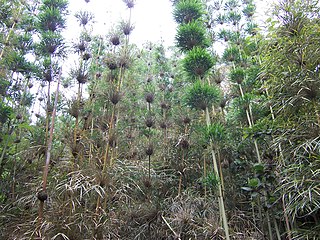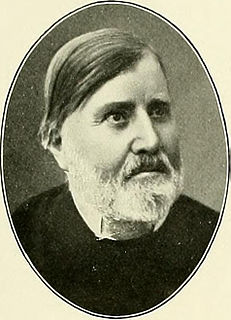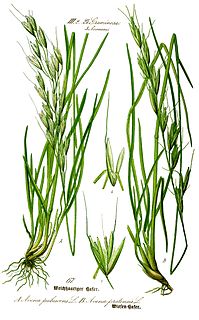
Lolium is a genus of tufted grasses in the bluegrass subfamily of the grass family. It is often called ryegrass, but this term is sometimes used to refer to grasses in other genera.

Nastus is a genus of slender, erect, scrambling or climbing bamboos in the grass family. It is native to Southeast Asia, Papuasia, and certain islands in the Indian Ocean.

Tragus, commonly called bur gras, burr grass or carrot-seed grass, is a genus of plants in the grass family. It is native to Africa, Australia, and Eurasia with several species on islands in the Atlantic, Indian, and Pacific Oceans plus one species in Argentina.
Nicaise Auguste Desvaux was a French botanist.

Ernest Saint-Charles Cosson was a French botanist born in Paris.
Auguste Jean Baptiste Chevalier was a French botanist, taxonomist, and explorer of tropical Africa, especially of French colonial empire in Africa that included Côte d'Ivoire. He also explored and collected plants in South America and tropical Asia. Chevalier was a prolific contributor to the knowledge of African plants, studying forest trees and their woods, grasses, and agricultural plants of the continent. Unlike other botanists who studied the plants of tropical Africa, Chevalier also ranged to the floral regions of the Sahara.
Ammochloa is a genus of Mediterranean plants in the grass family, Poaceae.

Catapodium is a genus of Eurasian and North African plants in the grass family.
Xerocoprinus is a fungal genus in the family Agaricaceae. This is a monotypic genus, containing the single species Xerocoprinus arenarius, originally named Coprinus arenarius by Narcisse Théophile Patouillard in 1896. Xerocoprinus was circumscribed by French mycologist René Maire in 1907.
Vulpiella is a genus of plants in the grass family. The only known species is Vulpiella stipoides, native to the western Mediterranean region.
Narduroides is a genus of Mediterranean plants in the grass family. The only known species is Narduroides salzmannii, native to Spain, France, Morocco, Algeria, Libya, Cyprus, and Turkey.
Ochthochloa is a genus of desert plants in the grass family native to the Sahara and Arabian Deserts. The only known species is Ochthochloa compressa, whose native range extends from Algeria to Uttarakhand.

Aristea ecklonii is a plant species in the Iridaceae, first described in 1866. It is native to central and southern Africa from South Africa north to Cameroon and Tanzania. The plant is an evergreen perennial with small, blue flowers, growing in clumps with upright, grass-like leaves 15–18 in (38–46 cm) in height.
René Viguier was a French botanist known for his investigations of plants within the family Araliaceae.

Lapiedra is a genus of Western Mediterranean plants in the Amaryllis family. It now contains only one known species, Lapiedra martinezii, native to Spain and Morocco.

Clitandra is a genus of flowering plants in the family Apocynaceae, first described as a genus in 1849. A total of 46 names have been coined since that time for species, subspecies, and varieties within the genus, but most of them have been transferred to other genera. The genus is currently regarded as containing only one species, Clitandra cymulosa, native to tropical Africa.

Avenula is a genus of Eurasian flowering plants in the grass family. Over 100 names have been proposed for species, subspecies, varieties, and other infraspecific taxa within Avenula, but only one species is accepted. The others names are all regarded as synonyms of other accepted names. The only recognized species in the genus is Avenula pubescens, commonly known as downy oat-grass or downy alpine oatgrass, native to Europe and Asia from Iceland and Portugal to Xinjiang, Mongolia, and Siberia. It is also naturalized in scattered locations in North America, in states as Connecticut, Delaware, Minnesota, New Jersey and Vermont, and in Canadian provinces such as Alberta, Manitoba, Ontario, Quebec, and Saskatchewan.
René Verriet de Litardière was a French botanist.
André Aubréville was a French botanist, professor at the National Museum of Natural History in Paris and a member of the Academy of Sciences. He was the first scientist to introduce the term "desertification" (in his 1949 book: Climats, forêts et désertification de l'Afrique tropicale, and wrote a number of floras of former French colonies.








